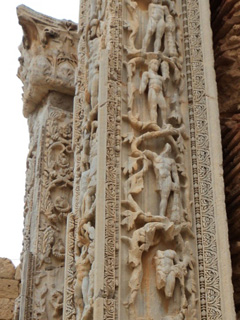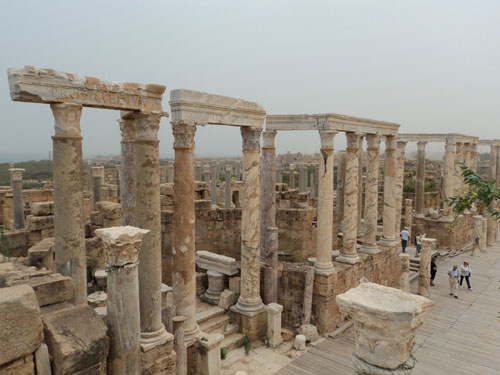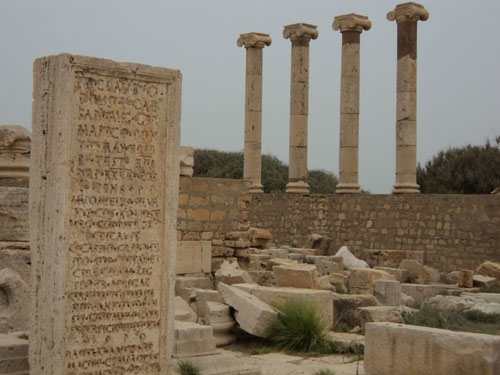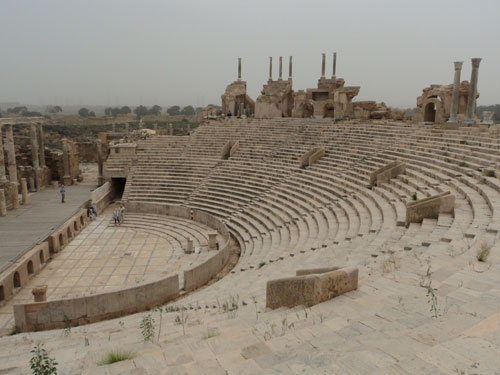Al Khums, Libya Who would have thought that the uprisings in Tunisia last January would bring about such an upheaval in world history? The Arab Spring unrest this year spread through Egypt, Syria, Jordan, and even Bahrain. It has also reached Libya, the large, North African country ruled for so many decades by Col. Moammar el-Quadaffi. For the past six months, the country, which is about 70 per cent desert, has been rocked by conflict: so many lives lost, the day-to-day routine of the citizens inevitably changed. My husband Alex and I were in Libya three months before the catastrophic events overtook the country. While there, one of our Filipino friends urged us to visit a place called Leptis Magna, about 100 km. east of the capital Tripoli. It was the first time we had heard of the place, and indeed it was mentioned in our guide book as a “must-see" for its well-preserved ancient architecture. Such mild descriptions, we later discovered, because Leptis Magna offered so much more. We reached the place after an hour and a half drive from Tripoli: friends Al and Gina, driver Mang Pinto, Alex and I, and. The very first structure that greeted us simply took our breaths away: a huge triumphal arch facing the four cardinal points, intricately carved, and so well-preserved it might have been done only a few years back. This was the Septimius Severus arch, guarding the whole place.

The Severus Arch at the entrance of Leptis Magna
Leptis Magna was founded by the Phoenicians as one of their important trading posts in the Mediterranean, along with Carthage in Tunisia at around 1000 BC. With the Roman conquest, it fell under the Empire, together with other Roman African colonies. At around 193 BC one of its prominent sons, Lucius Septimius Severus, became the Roman Emperor, and his hometown became the recipient of grand spending. Lavish architecture and tax exemptions were bestowed on Leptis Magna and its populace. Intricate buildings like a huge basilica, fora, market places, and sumptuous places for baths were erected. Invasions by many powerful countries later wrought havoc to the area, and Leptis Magna was brought under several different rulers, including German tribes called the Vandals who destroyed many parts of the city. When Rome later lost much of its sway, Leptis Magna fell into ruins and was abandoned. Because Libya was mostly desert, the beautiful city slowly disappeared under sand, and it was not until the Italian rule of the country after WWII that excavation of the site was started. In 1982 it was declared a UNESCO World Heritage Site. We exclaimed with delight at the entrance walkway: large square, cut-stones artfully laid out like huge mosaics under our feet. The archway itself was a reminder that this was a Roman site, its columns reminiscent of those in present-day Rome. As we went further we noted various ruins lying nonchalantly on the grounds: broken columns, carved stone tablets with Roman inscriptions, pieces of what looked like a portion of a temple’s roof with flowers and fruit carved on them. We reached the Palaestra, the Sporting Ground, a huge open field surrounded by the remains of tall colonnades. One can imagine the citizens enjoying themselves here -- probably jogging, boxing, or even doing archery, as the space was so large it could contain one football field.

Elaborate sculptures on one of the pillars of the Septimius Severus Basilica
To the right were the Baths, a leisurely pastime that ancient Romans could never do without. There were even divisions as to temperature: Tepidarium for tepid water, Caldarium for the hot (probably the sauna), and an open air swimming pool called the Natatio. Surrounding these were labyrinthine stone ways that could mesmerize and disorient: once I had to shout to the others, as it seemed the alleyways led nowhere and I was suddenly back where I came from. This in spite of the bright sun! One thought struck me as we were wandering about amidst the ruins: we didn’t meet anyone since we came in! For such a spectacular excavation site, there were no other visitors. Did we miss something, we asked ourselves. It was a Thursday, a day before Prayer Day (Friday) which was essentially the weekend, but how about other visitors? Nonetheless it was exciting to have such a magnificent site to ourselves, a place that one can wander off unmolested. May it remain so for longer, I prayed. We were approaching what looked like a temple from afar, and I could discern a mammoth ark (not unlike that of the Lost Ark of the Covenant), the chest supported high into the very skies by two very tall pillars. Around it were colonnades, and standing below the round pillars I squinted up and could recognize two winged griffons, looking ferocious, bearing the ark. The place had a charged atmosphere, as if some pent-up energy were lying in wait; surrounded by these ancient walls and pillars, I couldn’t help but shiver and feel the hair on my arms and nape stand on end. We were at the Severus Basilica, and some of the pillars had marble stones finely and intricately carved with human figures dancing among trees and plants.

Almost intact Roman pillars and stone works dwarf the author's friends below
Just beside this basilica was another open air colonnaded area, the Forum. At the sides were stone steps, and I can imagine the learned, the teachers, and the students going about their businesses here. Or when the citizens gathered to discuss issues publicly. Such a civilized society, it seemed!

Remains of the Forum
The extant houses near the Forum were almost intact; some were two storeys high. Among the ruins, too, were arches bearing beautifully-carved faces; with delight we discovered that the “human faces" were Gorgons, with snakes as hair.

Gorgon heads on archways
At about this time we heard people’s voices, speaking in Spanish. Indeed, a group of middle-aged men and women were coming in, their Castellano distinctive from the tour guide’s South American accent. There were about ten of them, all excited and agog at seeing the site. After exchanging “Holas!" with two ladies (one of them looking askance at my umbrella as I was afraid of the scorching sun) we learned that they were mother and daughter from Madrid, and the latter was into North African studies at the university. The sea was not far away, reminding us that the Phoenicians no doubt took the sea route to reach this coastal area of Africa. A quiet contemplation of the sea before us, seen from the high vantage point of an outcropping of a cliff just off the nearest ruin, soothed our sweat-drenched bodies. Legs still sturdy we walked further and reached the Market Place, a round building with open windows and some more pillars outside. Friend Al, who had just learned the Eight Silken Treasures Quigong that week, started to do the meditative exercises and I joined in. Amidst the tranquil ruins we did the contemplative breathing exercises, slowly bending from the waist, reaching up into the sky with our arms, stretching, stretching, stretching. It was only a 10-minute activity, but we felt more refreshed and alert than ever. Plus, we gained the bragging rights of having done quigong amidst the Leptis Magna ruins.

The tranquil Market Place
We finally reached the “circus" or the racetrack, an oval amphitheater with stone seats facing a throne-like, elevated area where the emperor probably sat during the games, after some more walking. Climbing up and sitting on one of the benches on the top tier of the amphitheater, we could see the Mediterranean Sea from afar. Letting our eyes roam the fields, we marveled at the idea that there were still undiscovered layers here, lying deep under the African sun, as our guide book reminded us. Secrets as yet unearthed!

Oval amphitheater with stone seats
Indeed, who would have thought that this tranquility will be marred three months later by so much instability and unpredictability?
C’est la vie, my friend Al who is still there, sighs. We who look on from afar, pray for peace to come soon, soon! And may Leptis Magna withstand this catastrophe, as it always had, millennia before. And yes, Al still does his quigong exercises everyday! -
YA, GMA News 









